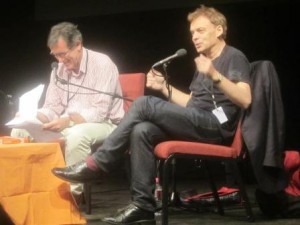Graeme Simsion has a physics degree, a PhD in Creativity Theory, a few screenplays, short stories, two nonfiction novels under his belt, and now a bestseller. He was one of the authors I was keen to see at the 2013 Perth Writers Festival. Much has been said about his book The Rosie Project, which was published in January this year and been sold into 34 countries. I was particularly interested in what happened behind the scenes. Here’s a summary of his thoughts on: how to make a character likeable; his writing process; editing; and bidding wars.
 |
|
Graeme Simsion Perth Writers Festival 2013 © The Ponder Room
|
The Rosie Project
The Rosie Project is an easy read, a mixture of Big Bang Theory, When Harry Met Sally and Perfect Match. It tells the tale of Don, an awkward academic whose personality boarders on Asperger’s, who designs ‘The Wife Project’, extensively a sixteen-page questionnaire which will ferret out his perfect match … or will it?
The Writing Process
The Rosie Project started as a screenplay in 2007 for an RMIT screenwriting course Simsion was taking. When asked about his process, he said he began by drawing on what he already knew … writing a screenplay because ‘it was easier’. His strategy was to finish the screenplay and then rework it as he ‘learnt more about writing’ in a novel writing course he was taking.
‘I thought I can’t write a novel but I can write a screenplay.’
As a screenwriter he knew the emphasis had to be on ‘the story’, and that the time in which to tell it was short. However along the way he also realised that the ‘best bits were the comedy’. Some of this insight came through sharing early chapters of the project in class … always a daunting prospect.
That reworking extended to ‘at least 70 drafts’, something the interviewer suggested could be a world record. It also included a long period where the manuscript had been ‘thrown in the bin.’ Even now he still considers reworks …
‘When I saw it on the shelf I thought I could’ve changed this and that’, and then sounding a bit like his character he added, ‘the design is never finished there is always something that you can make better … but that’s how design theory is.’
In his defence he added that ‘people like to kid themselves that they can write a book quickly, but it takes 10,000 hours to become expert at anything.’
Nowadays Simsion’s writing process is dictated by his day job.
‘As a subcontractor I may run courses for a few days and then have weeks free, so it’s intense bursts … 20,000 words over three days or on a weekend.’
In another similarity to his character, Simsion’s writing approach does involve planning and he still writes using a linear, scene by scene, screenwriting process.
‘I plan it from the top down so you can pick it up at anytime.’
The value of an editor
Simsion described the editing process as a period of ‘stretching and compressing’ and acknowledged how much he owed to this process.
‘It was a case of, ‘this scene is funny stretch it, this isn’t compress that’ …We started with 80,000 words then took out 10,000 and replaced them with 5,000 and then another 2,000 … I was given a master class in writing, … the editor helped me become a better writer.’
Throughout the process the draft ‘changed out of sight with only two characters remaining.’
Publishing bidding wars
In May 2012 the refined manuscript was sent to various publishers who were … not interested. It did however end up in three slush piles. At the same time Simion entered the unpublished manuscript into the 2012 Victorian Premiers Literary Award … and won. Considering this he then contacted the three publishers who had it in their slush piles, and ‘a couple more came on board.’
While he and his partner were having a break in a remote location, (that didn’t have mobile phone reception), a bidding war had begun. It wasn’t until they were finally back in phone reception that he knew what was going on.
Making an unlikeable character likeable
The protagonist in The Rosie Project, Don, has been described as a ‘nerd’ or ‘dork’, who is looking for love. When I read it, he appeared as Sheldon from Big Bang Theory. Simsion said that while on the surface the character is hard to sympathize with, it was important that the reader found him likeable. This he suggested, could be achieved by two approaches: having the character do something nice like ‘pat the dog’. Alternatively he could be given a goal, and a date that it has to be completed by. Add in the fact that he’s underequipped for the task and most importantly that he never gives up.
‘If he has a strong goal, a challenge that is beyond his reach and yet he goes for it.’
The Rosie Project was one of few books I took home from the festival. It’s not rocket science, but it is an easy, feel good romantic comedy. Simsion’s story however is inspiring and reminded me of the importance of persistence, and keeping within phone reception areas. Or maybe that’s the secret … stop worrying, take off and just let whatever will be, will be.




